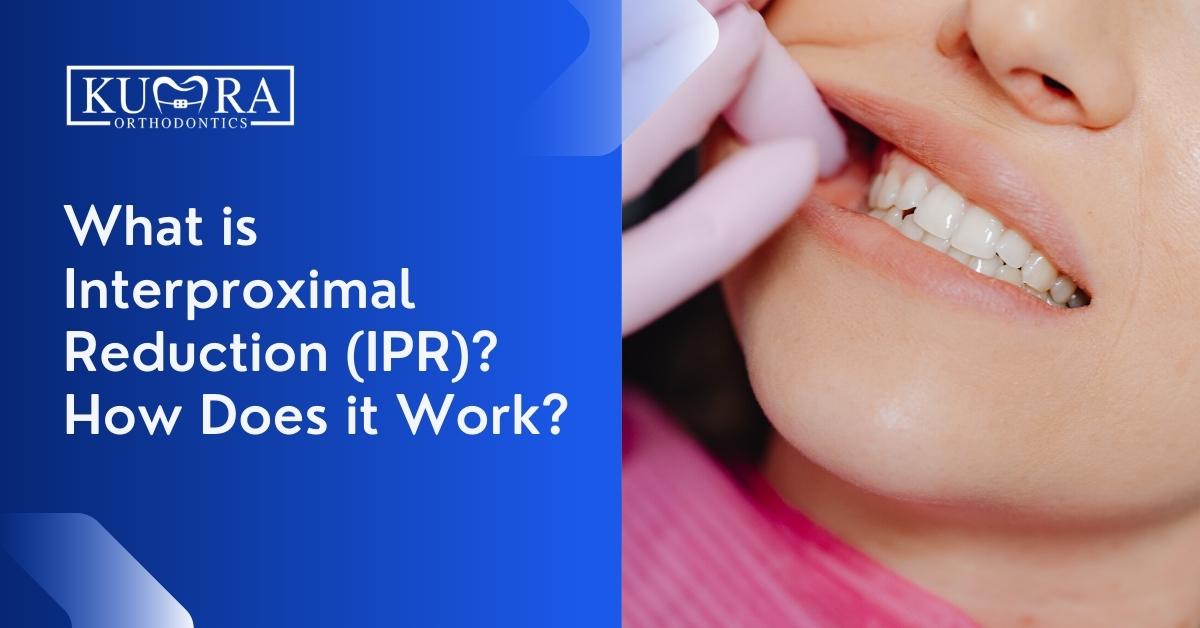Taking a journey into the world of orthodontics can sometimes feel like navigating through a maze of medical terminology and complex procedures. Among these, Interproximal Reduction (IPR) stands out.
Although it may sound intimidating, IPR is, in fact, a routine technique utilized by orthodontists worldwide. But what is it really? How does it function, and under what circumstances might it be necessary for you?
In this comprehensive guide, we aim to dispel the mysteries surrounding IPR. We’ll dissect its purpose, walk you through the process step-by-step, and illustrate how it plays a pivotal role in crafting stunning, healthy smiles.
Dive in and empower yourself with the knowledge to make informed decisions about your dental health.
What is Interproximal Reduction (IPR)?
Interproximal Reduction, or IPR as it’s often abbreviated, is a routine procedure in the field of orthodontics. You might also hear it being called tooth polishing, stripping, or slenderization – different names but all referring to the same process.
So, what does IPR involve? At its core, IPR is about adjusting the width of your teeth to prepare them for an upcoming orthodontic treatment. It achieves this by carefully removing a thin layer of enamel from the spaces between your teeth. Think of it as a dental ‘fine-tuning’ – making minor adjustments to ensure everything fits perfectly.
One of the key advantages of IPR is that it provides a practical alternative to more invasive procedures like dental extraction. Plus, it’s particularly beneficial for tackling issues of mild to moderate crowding, helping to create the space needed for a more harmonious alignment of your teeth.
In essence, IPR is a technique that’s all about precision and preparation, setting the stage for successful orthodontic treatments and a healthier, happier smile!
How Does IPR Work?
Wondering how IPR works? This procedure is essentially about creating tiny spaces between your teeth. These small gaps are crucial for enhancing alignment during orthodontic treatments. IPR is often used alongside treatments like Invisalign and braces, helping to perfect the positioning of your teeth.
When there’s a need for a little extra room to alleviate crowding issues, interproximal enamel reduction becomes a vital part of your orthodontic treatment.
Does IPR Hurt?
The term ‘reduction’ might seem a little intimidating, but rest assured that IPR is a standard, safe, and generally painless procedure. It involves a gentle sanding or polishing of the enamel – the outer layer of your teeth. A specialized tool is used to carefully grind away a small amount of enamel, creating the necessary space.
Since this process only affects the outer layer of the tooth, it is usually pain-free. However, as with any dental procedure, personal experiences can vary.
A few people might experience some minor discomfort. It’s always important to discuss the procedure in detail with your orthodontist or dentist, so you fully understand what it involves.
Reasons for Interproximal Reduction
Interproximal Reduction (IPR) is a widely employed procedure in orthodontics, used to address a variety of dental issues. Let’s delve into the primary reasons why IPR is utilized.
Space Creation for Orthodontic Treatment
A common application of IPR is to create additional space between teeth for orthodontic treatments such as braces and Invisalign. By slightly reducing the width of the teeth, dentists can carve out room for superior alignment and positioning of the teeth.
An Alternative to Tooth Extraction
In certain scenarios, IPR serves as a less invasive alternative to tooth extraction. This is particularly beneficial when dealing with minor overcrowding issues, where tooth extraction may seem overly drastic.
Enhancement of Aesthetics
Beyond its practical applications, IPR can also make a significant contribution to the aesthetic appeal of your smile. It does this by creating uniform spaces between your teeth and improving their alignment, resulting in a more harmonious and attractive smile.
Needing an orthodontic appointment?
Visit Kumra Orthodontics Washington, DC or Kumra Orthodontics Stafford, VA, and request an appointment with us!
Pros
Like all dental procedures, Interproximal Reduction (IPR) has a set of unique advantages. Here are some of the key benefits that make it a popular choice in orthodontics.
A Less Invasive Option
In the realm of dental procedures, tooth extraction is often viewed as a last resort due to its invasive nature. Conversely, IPR offers a less intrusive alternative. It involves the careful removal of a minimal amount of enamel from the sides of your teeth – a process that’s far less daunting than having a tooth completely removed. This makes IPR an ideal choice for minor dental adjustments and corrections.
Swift Procedure
One of the appealing aspects of IPR is its efficiency. The procedure typically can be completed in one or two visits to the dentist, depending on the extent of reduction required. This quick turnaround time is a significant advantage for patients seeking to improve their dental alignment without enduring lengthy treatment periods.
Enhanced Dental Alignment
IPR isn’t just about making space; it’s about creating harmony in your smile. By fine-tuning the width of your teeth, IPR aids in achieving improved dental alignment. The result? A more symmetrical, well-balanced, and aesthetically pleasing smile that boosts your confidence.
Cons
While IPR has numerous benefits, it’s also important to consider its potential downsides. Here are a few things to keep in mind:
Potential Increase in Tooth Sensitivity
IPR involves the removal of tooth enamel, which serves as a protective layer for the sensitive inner parts of your teeth. As a result, you might experience increased tooth sensitivity following the procedure, particularly when consuming hot or cold foods and beverages. However, this sensitivity is usually temporary and should subside over time.
Irreversibility of the Procedure
Once enamel is removed through IPR, it can’t be replaced. This permanence makes it crucial for you to have a thorough discussion with your dentist about whether this procedure is the most suitable option for you.
Considerations should include your current dental health, the extent of overcrowding, and the potential benefits and risks of the procedure.
Need for Professional Supervision
The success of IPR largely depends on the skill and experience of the professional performing it. Improper handling during the procedure could potentially lead to damage to the teeth or gums. Therefore, always ensure that your IPR procedure is carried out by a trained and experienced dental professional.
Possible Risks of IPR
As with any surgical procedure, IPR also comes with its own set of potential risks. It’s crucial to consider these risks and have an open discussion with your dentist before deciding to proceed.
Risk of Enamel Damage
One of the primary risks associated with IPR is potential damage to the tooth enamel. The procedure involves the shaving off of a minimal amount of tooth enamel to create space between teeth. If performed incorrectly or excessively, it can lead to the tooth becoming susceptible to issues such as tooth decay or cavities.
Enamel serves as a protective layer for the tooth and once damaged, it cannot regenerate. Hence, it’s imperative that the procedure is carried out by a skilled dental professional who can ensure only the necessary amount of enamel is removed, preserving the health of your teeth.
Possibility of Gum Irritation
Another risk to take into account is gum irritation. During the IPR process, the tools used could potentially irritate the gums, leading to discomfort, swelling, or even bleeding in certain cases.
While this is typically temporary and can be managed with proper oral hygiene and care, it’s still an important factor to consider when deciding whether to proceed with IPR.
Chance of Misalignment
The final risk to consider is misalignment. If an excessive amount of enamel is removed during the IPR procedure, it could adversely affect the alignment of your teeth. This could result in bite problems that may necessitate further orthodontic treatment to rectify. Therefore, utmost precision and care are needed when performing this procedure to ensure only the required amount of enamel is removed.
Interproximal Reduction FAQs
How much interproximal reduction is safe?
Generally, dentists agree that no more than 50% of proximal enamel should be removed during an Interproximal Reduction (IPR) procedure. Teeth usually have 1.5-2 mm of enamel, so it’s typically safe to do more than 0.5mm of IPR on a tooth. However, removing more than 0.3 mm of IPR at once can cause problems. As such, it’s recommended to do IPR in 0.3 mm increments.
More specifically, up to 0.2 mm can be safely removed from each proximal surface of the mandibular central incisors, 0.25 mm from the laterals, and 0.3 mm from another teet
Can Invisalign be done without IPR?
Yes, Invisalign can be performed without IPR. However, the need for IPR depends on the individual’s dental condition, including factors like the degree of crowding, the size of the teeth, and alignment goals. Your orthodontist will assess your specific situation to determine the most appropriate treatment plan.
Read more: How Long Can You Go With a Loose Bracket
Ready to Improve Your Smile with Kumra Orthodontics?
Now that you’re equipped with a comprehensive understanding of Interproximal Reduction (IPR), it’s time to take the next step. As a top-rated orthodontist in Washington, DC, Kumra Orthodontics is dedicated to providing exceptional dental care tailored to your unique needs. Whether it’s IPR, braces, Invisalign, or any other orthodontic treatment, our skilled team is ready to guide you towards a healthier, more radiant smile.
Don’t let dental jargon intimidate you. Our friendly professionals in Washington, DC are here to walk you through every step of the process, ensuring you’re comfortable and informed. We’re committed to helping you achieve your dream smile in the most effective, pain-free way possible.
Ready to start your journey to a happier, healthier smile? Contact Kumra Orthodontics, your trusted orthodontist in Washington, DC, today and schedule your consultation. Let’s craft the perfect smile together!



